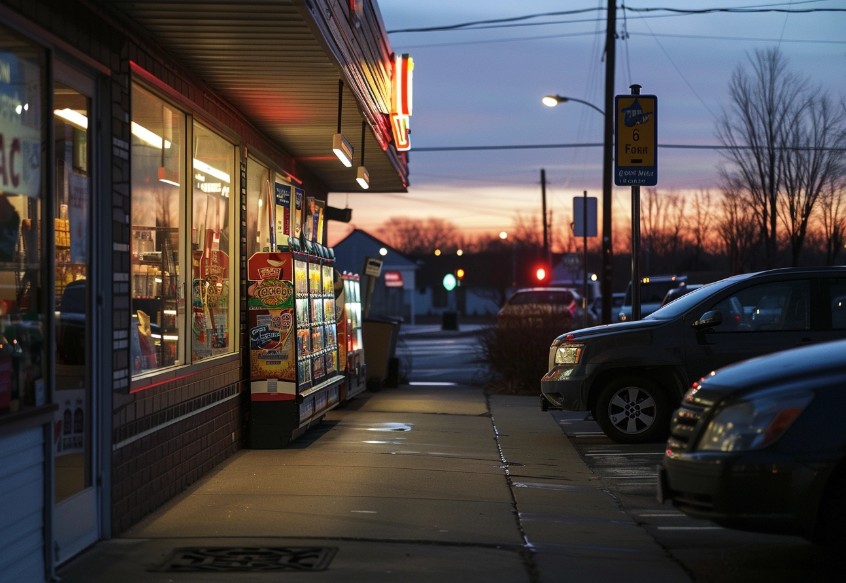
The Challenges Behind C-store Site Selection for Tampa Real Estate Developers
Choosing the right location for a C-store involves challenges that go way beyond simple location hunting. The difference between a thriving convenience store and a struggling one often depends on which side of the road you’re on. PM traffic customers generate 4-5 times larger ticket sales than morning shoppers. This seemingly small detail becomes vital to success.
Our work with Tampa real estate developers shows how the convenience store landscape keeps changing. A typical C-store draws about 1,100 customers daily. The razor-thin margins on gasoline (only about 3 cents per gallon after expenses) have led commercial real estate developers in Florida to focus on locations that support diverse revenue streams. On top of that, retail industry pressures and the need for stronger store network justification have made the site selection process more evidence-based than before.
This piece will get into the key factors behind successful C-store site selection. We’ll look at traffic patterns, demographic considerations, physical site requirements, and strategic collaborations that can maximize your investment potential in the Tampa market.
Understanding the Core Criteria for C-Store Site Selection
A successful C-store needs careful analysis of demographic and traffic data to pick the right location. C-stores work differently from other retail stores – they need specific population and traffic numbers to stay profitable. Tampa’s real estate developers must review these numbers carefully before choosing store locations.
Population density standards in Tampa
Population density forms the base for any C-store’s success. Tampa now has 3,376.4 people per square mile, which shows a 14% jump from 2,960.2 back in 2010. These growing numbers make Tampa a great spot for new convenience stores.
Florida’s commercial real estate developers need to understand Tampa’s quick population growth. The city saw a 4.9% rise in residents from April 2020 to July 2023, reaching 403,364 people. This growth shows there’s plenty of room for well-placed C-stores to thrive.
Median income standards for good locations
Income levels strongly affect how well C-stores perform. Tampa’s median household income of $71,302 beats many national standards for running a profitable C-store. But 15.9% of Tampa residents live in poverty, which means developers need to look at each neighborhood carefully.
Frank David Capitano runs The Radiant Group with 14 stores around Tampa. He says: “We think demographic information can make or break a site’s success. We try to know our target customers and make sure we stock what they want”. So stores in richer areas might stock premium items, while stores in lower-income areas focus on value products.
Traffic volume and vehicle counts
Traffic data might be the most important factor in a C-store’s success. Experts say you need 25,000 to 30,000 cars passing daily to get enough customers. The direction of traffic plays a big role too:
- Stores on the PM traffic side do better because evening shoppers spend 4-5 times more than morning customers
- Morning customers usually buy small items like coffee and cigarettes, while evening customers buy pricier things like beer, cartons, and dinner items
- Too much traffic can hurt business, as NOCO’s Mike Newman points out: “Very high traffic can actually harm a site”
Developers should look at Average Annual Daily Traffic (AADT) data to find steady traffic patterns throughout the year. The City of Tampa keeps track of traffic on major roads, which helps make smart choices about where to put new stores.
Evaluating Physical Site Attributes
Physical features of a potential C-store location shape its success now and in the future. Tampa real estate developers need to review these concrete characteristics and demographic data to find the best spots.
Minimum and preferred frontage
Frontage needs change based on zoning rules and how visible the store needs to be. Tampa’s commercial properties must follow Section 27-9 zoning regulations that affect “height and bulk of buildings, population density, lot coverage, yards and other open spaces”. C-store frontage minimums aren’t the same everywhere, but developers look for properties with plenty of road-facing space to make stores easy to see and reach.
Lot size and parking availability
Tampa’s successful C-stores need enough room for both the building and parking space. Recent listings show that workable convenience stores usually take up buildings between 2,394-2,500 square feet on lots around 0.34 acres.
Parking space plays a huge role in picking the right spot. Research by the High Streets Task Force ranks parking as the 8th most important factor out of 237 elements that affect retail success. On top of that, 38% of shoppers say available parking would make them more likely to visit local businesses.
Visibility and access from main roads
Store performance depends heavily on being visible from major streets. Retail stores that people can see from main roads get 25% more foot traffic. About 70% of shoppers say a store’s location affects their decision to visit.
Tampa’s road system offers many high-visibility spots. The city has five main highways including I-275, I-4, Veteran’s Expressway, Leroy Semon Cross Expressway, and I-75. These big roads, along with east-west connections like Kennedy Boulevard and Gandy Boulevard, create great opportunities to be seen.
The best spots let customers drive in and out easily. Industry experts point out that even places with perfect traffic numbers might struggle if customers find it hard to get in or out, especially during rush hour. Finding the sweet spot between being visible and easy to reach makes all the difference in picking a winning C-store location.
The Role of Co-Tenancy and Retail Synergy
Nearby businesses affect C-store performance by a lot. Retailers see 25% higher profits when they’re surrounded by the right mix of other stores. Tampa real estate developers need to look beyond traffic counts and lot sizes. The right mix of neighboring stores creates powerful benefits.
Why anchor tenants matter
Anchor tenants are the life-blood of retail developments. They pull in huge crowds that help smaller nearby stores thrive. These big retailers—usually big-box stores or grocery stores in strip centers—make commercial properties more credible. C-store developers get several perks by setting up shop near anchor tenants:
- They bring a steady flow of potential customers
- They confirm the spot works for retail business
- They make the whole area more appealing
Landlords give anchor tenants big breaks on rent because these stores play a vital role in bringing business to nearby properties. Tampa developers should look for spots near 10-15 year old anchor tenants that still have plenty of time left on their lease.
Common co-tenants for successful C-stores
The best tenant mix creates benefits between stores that work together instead of competing. Research shows 48% of retailers believe shoppers combine their trips, but real numbers show it’s actually 57%.
C-stores do well next to these businesses:
- Coffee shops (top secondary stop for grocery, apparel, and health/beauty shoppers)
- Fast-food restaurants (52% of grocery shoppers visit them)
- Dollar stores (54% of grocery shoppers go there)
Young shoppers (ages 18-34) combine trips twice as often as those over 60. This means locations that attract younger crowds benefit more from strategic store placement.
Effect of nearby QSRs and grocery stores
Being close to grocery stores and quick-service restaurants gives C-stores special advantages. Looking at foot traffic shows which brands attract similar customers, helping developers find the best spots.
Tampa’s competitive retail scene shows grocery-anchored centers are worth the most, with cap rates from 9.25% to 10.5% based on tenant credit strength. Casual restaurant chains like Chipotle and Boston Market keep growing in Tampa, which creates chances for smart store placement.
Smart store placement isn’t just about dodging competition—it’s about building retail ecosystems where businesses grow together through shared customers and services that complement each other.
Expansion Planning and Market Saturation
Real estate developers in Tampa must look beyond immediate site metrics and think over future market dynamics to plan their expansion. Tampa now has record-low retail vacancy rates of 3.2%. This makes careful analysis of market saturation crucial for C-store success.
How Tampa real estate developers assess trade areas
Trade area analysis works best by establishing multiple zones of influence around potential sites. Developers typically define these as:
- Primary Trade Area (PTA) – Where establishments draw the majority of regular sales and highest capture rates
- Secondary Trade Area (STA) – Contributing sales at lower capture rates
- Tertiary Trade Area (TTA) – Peripheral areas with minimal but measurable contribution
IMST Corp.’s CEO Travis Heiser points out that successful developers “follow the people—those relocating to new areas in search of better jobs, schools, affordable housing, quality of life”. Developers track household growth even before measuring job expansion to evaluate potential markets.
Balancing infill vs. new market entry
Tampa’s rapid growth gives developers a crucial choice between infill development and new market entry. The city’s urban core has become a growth hub, and East Tampa’s property values have risen more than 60% over five years.
Infill development costs more and needs complex financing, but it brings clear benefits. Tampa’s economic opportunity administrator Bob McDonaugh explains: “We’ve lost about USD 280.00 million in revenue… We would need to build our way out of it”. Tampa has made this easier by streamlining regulations with electronic plan submissions and pre-submittal reviews.
Using demographic projections for future-proofing
Tampa’s 4.9% population increase between 2020-2023 and expected in-migration of over 33,000 individuals in 2024create a solid foundation for C-store investments.
Demographic changes also need developer’s attention. Trade area analyses show Tampa will see higher growth in three age groups: 35-44, 65-74, and 75+. This demographic progress points to chances for specialized C-store concepts, especially in areas that show strong household growth.
